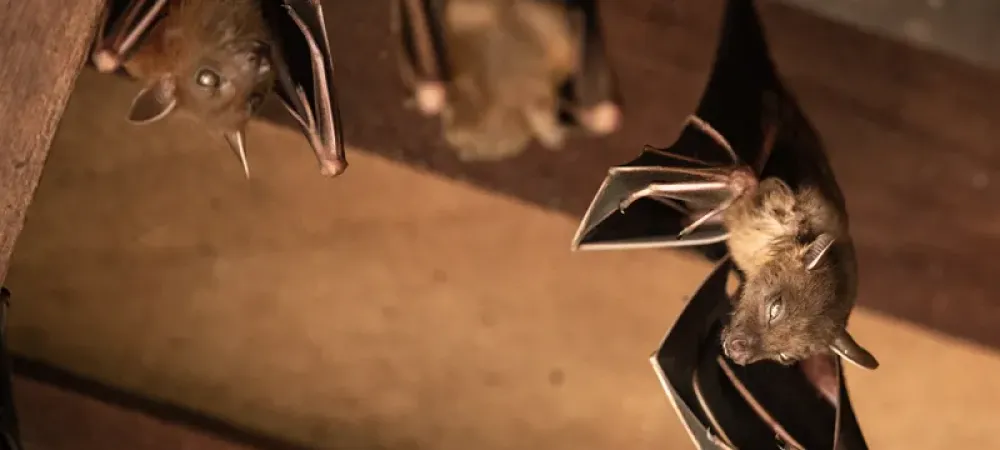How To Keep Bats Away

Bats play a crucial role in our ecosystem by controlling insect populations and pollinating plants. However, when they decide to roost in or around our homes, they can become a nuisance and pose health risks. In this guide, we will explore effective and humane ways to keep bats away from your home and property without causing harm to these valuable creatures.
What Attracts Bats To Your Home?
Before diving into solutions, it's essential to understand the reasons bats might be attracted to your property. Bats are drawn to places that offer shelter, warmth, and easy access to food. Common attractants include:
- Roosting Sites: Bats seek shelter in quiet, dark, and secluded spaces. Common roosting sites include attics, barns, and unused structures.
- Water Sources: Bats require water for drinking and hunting insects. Properties near water bodies or with standing water may attract bats.
- Insect Abundance: Bats feed on insects, and properties with a high insect population are more likely to attract them.
What Problems Do Bats Cause?
While bats provide essential ecological services, they can pose certain challenges when they come into close proximity to human living spaces. The problems associated with bats include:
- Disease Transmission: Some species of bats can carry diseases like rabies. While transmission to humans is rare, direct contact with bats, especially bites or scratches, can pose a risk.
- Guano Accumulation: Bat droppings, known as guano, can accumulate in areas where bats roost. The buildup of guano can create unsanitary conditions and may pose respiratory health risks if not managed properly. These droppings are also high in ammonia levels and can cause corrosion of metals and damage to buildings. The guano's high bacteria and acidity count could be toxic to you or your pets once ingested.
- Accidental Entry into Living Spaces: Bats may accidentally enter homes, causing panic or accidental contact. While the bats themselves are not inherently dangerous, the situation can lead to bites or scratches.
Protect Your Home from Bats
Residential areas tend to attract bats because they provide many tight spaces for bats to hide, live, and breed, like attics, vents, and corners of garages. Here are a couple of steps you can take to keep bats away from your home:
1. Seal Entry Points
Conduct a thorough inspection of your home and seal any potential entry points, such as gaps in the roof, vents, or openings in the attic. Use materials like caulk, mesh, or foam to ensure a secure barrier. Also, invest in some window screens to support the glass and prevent any bats from sneaking into your home.
2. Install Bat Houses
Provide an alternative roosting option by installing bat houses away from your living spaces. This encourages bats to roost in a designated area, keeping them at a distance from your home. Designated bat houses can easily be purchased online or at your local home supply store.
3. Use Repellents
Natural repellents like cinnamon, peppermint, and eucalyptus oils can deter bats due to their strong sense of smell. Apply these oils on potential entry points or use them as a spray around your property.
4. Eliminate Standing Water
Reduce the attractiveness of your property by fixing leaks and eliminating standing water, which not only attracts bats but also serves as a breeding ground for insects.
5. Trim your Trees and Bushes
Bats prefer to roost in areas where they can find shelter and be hidden from predators. This includes natural areas like trees and bushes. Give your shrubbery a trim every once in a while to reduce roosting opportunities.
6. Clean Up Fruit on the Ground
If you have fruit trees on your property, check for any fallen fruits around the house and pick them up, as they can serve as a food source for bats - as well as attract bugs, which bats will also feed on.
7. Create Light Barriers
Bats are nocturnal animals and are sensitive to light. Install motion-activated lights around your home, especially near potential roosting sites. These bright lights will discourage bats from settling in these areas.
8. Use Ultrasonic Devices
Ultrasonic bat repellent devices emit high-frequency sounds that are irritating to bats but generally inaudible to humans. Install these devices in areas where bats are likely to roost.
9. Professional Assistance
If the bat infestation is severe or if you're uncomfortable handling the situation yourself, seek professional help from a local pest control company. Wildlife experts can assess the situation and provide humane solutions, such as exclusion devices or one-way doors.
Call Wildlife Professionals
While it's essential to keep bats away from living spaces, it's equally crucial to approach the situation with empathy and environmental consciousness. Bats play a vital role in maintaining ecological balance, so opting for humane methods to deter them from your property ensures coexistence without causing harm to these beneficial creatures. By implementing the strategies outlined in this guide, you can create a bat-friendly environment while maintaining the sanctity of your living spaces.
Let these simple suggestions help you protect your home. Should you need help from an affordable, professional bat control in Colorado, contact Whitmore Pest Control and you’ll be well on your way to a safer home.
FAQ About Keeping Bats Away
When it comes to preventing bats from investing your home or property, here are some of the most common questions our team of pest experts receives:
Are Bats Dangerous?
Bats are generally not dangerous to humans when left undisturbed in their natural habitats. In fact, they play a crucial role in the ecosystem by controlling insect populations, pollinating plants, and even dispersing seeds. However, there are certain considerations to keep in mind:
-
Disease Transmission: While the risk is relatively low, some species of bats can carry diseases such as rabies. It's important to avoid direct contact with bats, as bites or scratches may pose a risk of disease transmission. If you come into contact with a bat, seek medical attention promptly.
-
Guano Accumulation: Bat droppings, or guano, can accumulate in areas where bats roost. The buildup of guano can create unsanitary conditions and may pose respiratory health risks, especially in enclosed spaces like attics. Proper cleaning and protective measures are necessary when dealing with guano.
-
Disturbance and Stress: Bats may become defensive if they feel threatened. If a bat is cornered or handled, it might bite in self-defense. Additionally, disturbing bats during their hibernation or maternity periods can cause stress and harm to the species.
-
Accidental Entry into Living Spaces: Occasionally, bats may accidentally enter human living spaces. While the bat itself may not be inherently dangerous, the potential for panic or accidental contact increases the risk of bites or scratches.
It's important to note that the vast majority of bats do not carry diseases harmful to humans, and they play a critical role in maintaining the ecological balance. Most bats are shy and will avoid humans if given the opportunity. If you encounter bats in or around your home, consider seeking professional assistance to safely and humanely address the situation. Wildlife experts can help with exclusion methods, installing bat houses, and other strategies that ensure the well-being of both humans and bats.
Can Bats Cause Structural Damage?
Bats themselves generally do not cause structural damage to buildings. However, certain issues associated with bat presence may indirectly contribute to structural concerns:
-
Guano Accumulation: Bat droppings, known as guano, can accumulate over time in roosting sites like attics or other enclosed spaces. The buildup of guano may lead to structural issues, as it can be corrosive and may compromise the integrity of building materials.
-
Urine Stains: Bat urine, when present in large quantities, can stain and damage building materials. This is more likely to occur with significant bat infestations or prolonged roosting in the same location.
-
Roof Entry Points: Bats may enter buildings through small openings, gaps, or cracks in roofs and walls. While bats themselves don't cause structural damage during entry, the openings they use can lead to water leaks, which may contribute to structural issues over time.
It's important to address bat infestations promptly to prevent potential secondary problems. Seeking professional assistance for bat exclusion, removal, and cleaning is advisable to ensure that both the structural integrity of the building and the well-being of the bats are taken into consideration. If you suspect bats are present in your home, consult with wildlife experts to assess the situation and implement appropriate solutions.
What Do Bat Nests Look Like?
Bats typically roost in sheltered areas rather than building nests like birds. The term "bat nest" is not commonly used, but bats may gather in colonies in locations called roosts. Bat roosts vary depending on the species, but common roosting sites include:
-
Caves and Crevices: Many bats prefer natural sites like caves, rock crevices, or hollow trees. They roost in these locations to stay sheltered and protected.
-
Buildings and Attics: Some bats adapt to human-made structures, roosting in attics, barns, or other quiet, dark spaces. In these cases, the roost may consist of bats clustered together rather than a traditional nest.
-
Bat Houses: Bat houses are artificial structures designed to provide roosting spaces for bats. These houses typically have narrow crevices or chambers where bats can roost in colonies.
The appearance of a bat roost depends on the specific species and the location. Bats don't construct intricate nests like birds; instead, they seek sheltered spots that offer protection from predators and the elements. If you suspect bats are roosting in or around your property, it's advisable to consult with wildlife experts for proper identification and guidance on humane management strategies.

